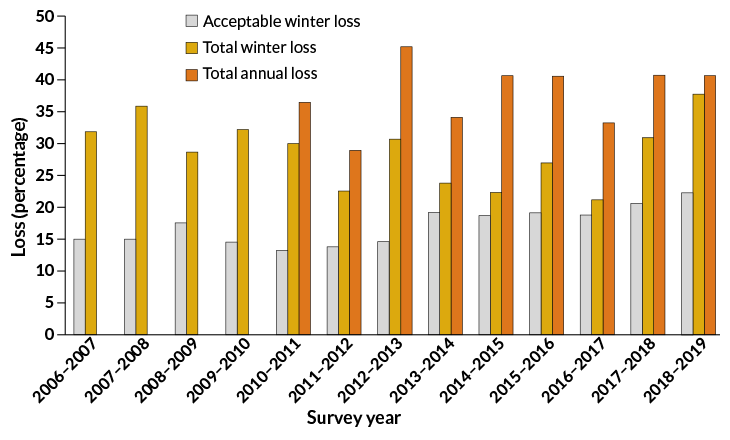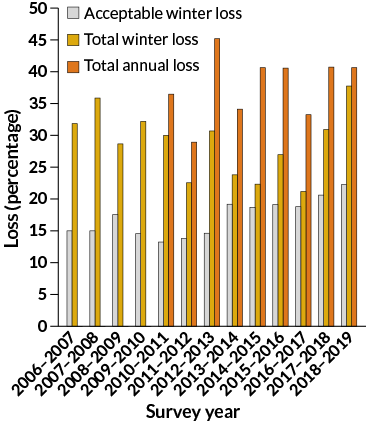U.S. honeybees just weathered an unusually bad winter.
About 38 percent of beekeepers’ colonies died between October 1, 2018, and April 1, 2019, the Bee Informed Partnership estimates. While it wasn’t the worst recent year overall for honeybee losses — that was 2012–2013 — preliminary results released June 19 show it is the worst winter die-off recorded over the University of Maryland–based nonprofit’s 13 years of surveying bee populations.
Beekeepers should be able to rebuild those numbers this year, but such ongoing winter losses raise deep worries about the future of crop pollination. On average over the 13 years, about 29 percent of colonies have died each winter. The 2018–2019 numbers came from nearly 4,700 beekeepers, representing about 12 percent of the estimated 2.69 million U.S. hives.

Sign Up For the Latest from Science News
Headlines and summaries of the latest Science News articles, delivered to your inbox
Client key* E-mail Address* Go
Thank you for signing up!
There was a problem signing you up.
Bee gone
Beekeepers say they could accept some percentage of loss in colonies during winter (gray bars), but actual winter losses (yellow) estimated over the past 13 years have been higher, according to an annual survey by the nonprofit Bee Informed Partnership. Colonies die in summer too, so starting in 2010, the survey included estimated colony losses during a whole year (orange).
Annual estimated U.S. honeybee colony losses, 2006–2019
 The Bee Informed Partnership
The Bee Informed Partnership  The Bee Informed Partnership
The Bee Informed Partnership
Some floods and fires this year destroyed colonies, but “the take-home worry for me is Varroa [mites],” says the Partnership’s Dennis vanEngelsdorp, a bee-health entomologist at the University of Maryland in College Park. The invasive mite species Varroa destructor clamps its tiny pimple-shaped body onto bees just as they’re turning into adults (SN: 2/16/19, p. 32). Mites sap bee strength and spread disease, yet remedies against the pests seem to be losing their power. “Ideally in the long-term, we would have a bee that was resistant,” vanEngelsdorp says.
While winter bee colony die-offs are worrisome, beekeepers can split surviving bee colonies and add new queens. Replacing winter-killed colonies this way, however, takes labor, time and money.
Only 5 percent or so of U.S. beekeepers work at the commercial scale that supplies 90 percent of bees pollinating the nation’s crops, vanEngelsdorp says. If the relentless drain of replacing winter losses drives them out of business, “it’s very hard to replace that group of beekeepers.”

